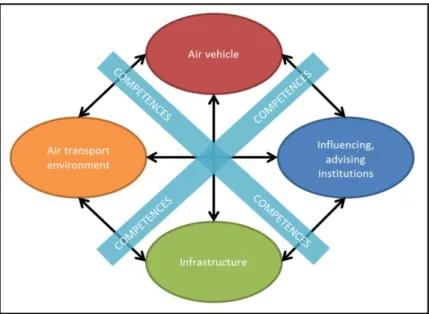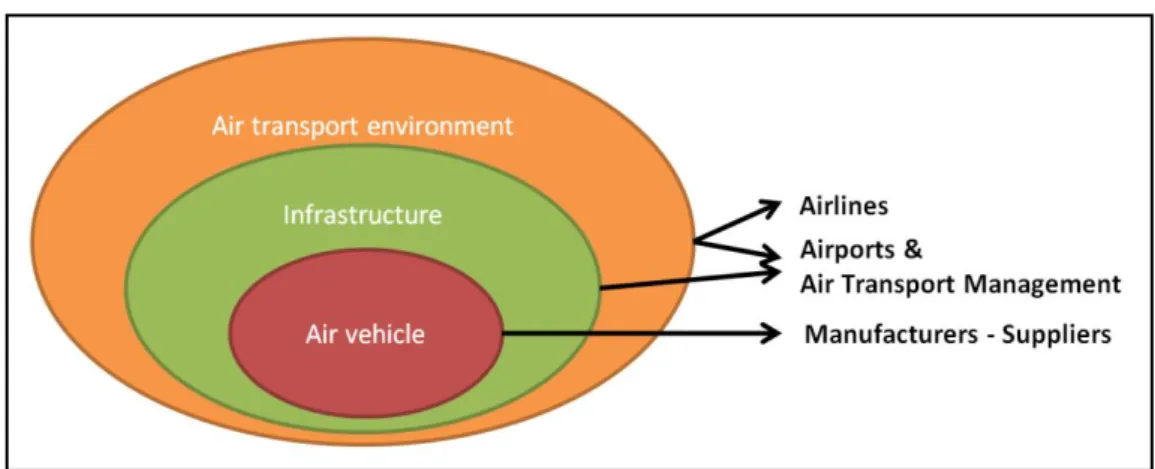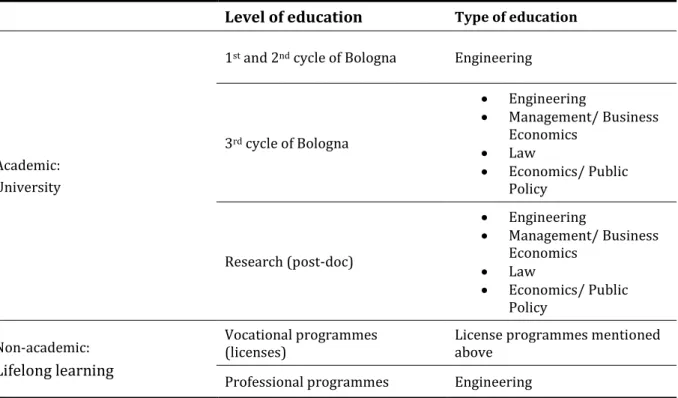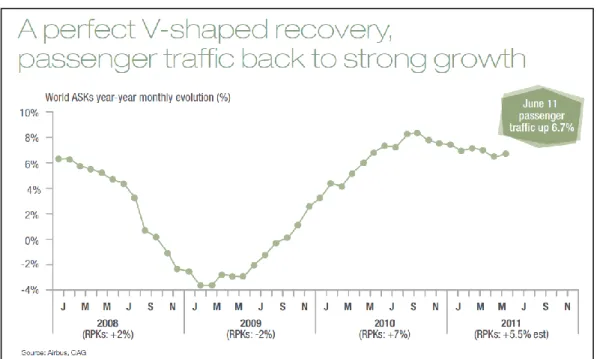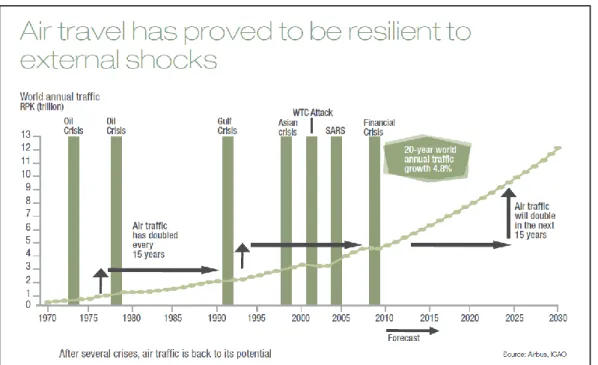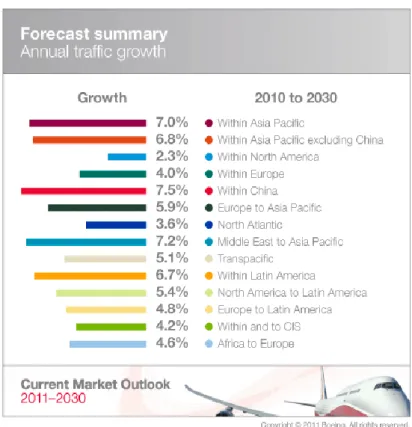In the first part of this delivery, the scope of the EDUCAIR project will be defined. In (the last section of) this part, the scope of the EDUCAIR project will be identified. To determine the scope of the EDUCAIR project, it is important to first look at the demand side of the aviation labor market.
Therefore, a structured approach is useful for the analysis of the demand side of the aviation labor market.
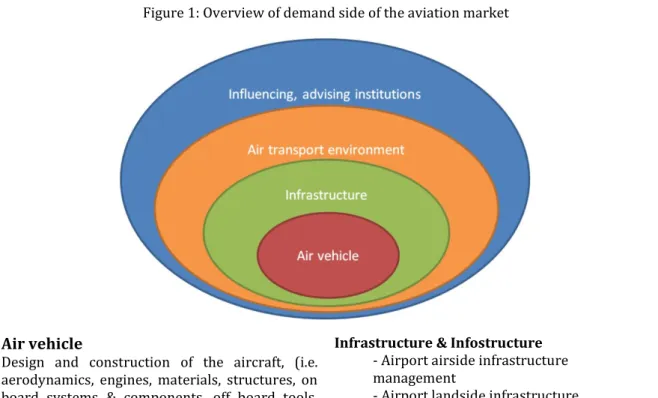
The supply side of the (civil) aviation labour market
When studying aviation and aeronautics education in more detail, a distinction can be made between basic education and supplementary programs. Basic education programs in air transport and aeronautics consist of several courses, spread over one or more years, evolving towards a diploma in air transport and aeronautics. Vocational programs are programs that prepare trainees for jobs that are based on manual or practical activities, traditionally non-academic and related to a specific occupation and training leading to a license in the air transport sector (such as Pilot, Air Traffic Controller, Aircraft Maintenance Mechanic, Aeronautical Station Operator and Flight Operations Officer).
The project focuses on engineering, which is related to air transport/aviation, when viewing the professional programs.
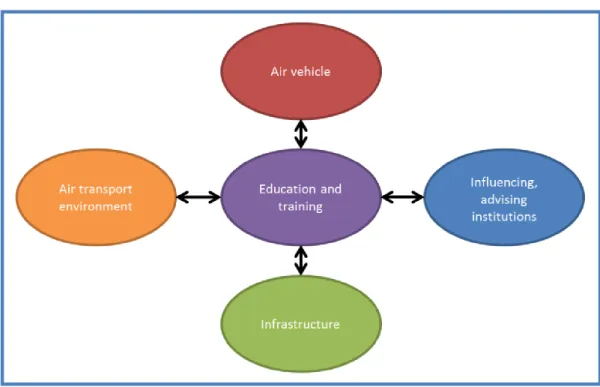
The proposed scope of the EDUCAIR project
3 Development of the air transport and aeronautics sector and educational techniques and tools.
3 Evolution of the air transport and aeronautics sector & of the educational techniques and tools
Market developments
- Global trends influencing today’s market
- The growth of the air transport sector
- Traffic flows
- Demand for innovations
- Conclusion market developments
Over the past twenty years, non-industry factors have helped drive the development of the air transport sector. These aircraft must be adapted to the nature of the markets they will serve. Forty percent will replace older aircraft and 3,800 new twin-aisle aircraft will contribute to segment growth.
This, in combination with growing prosperity, ensures an increase in demand for air transport.
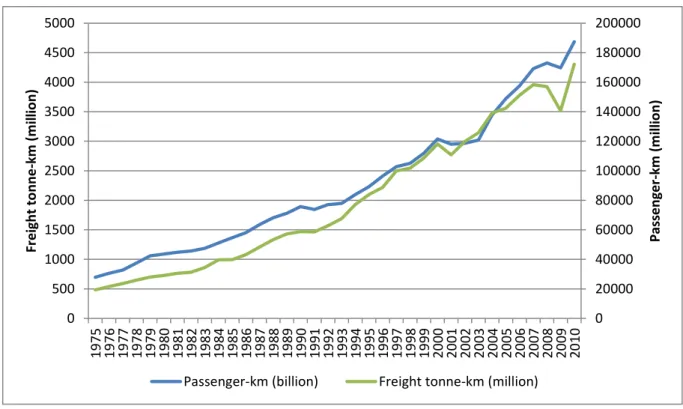
Developments in educational tools and techniques
- Impact of international focus on students
- Implementation of the international focus in education
- Effect on air transport related education?
- Changes in aviation-related training: some examples
The study highlighted that the majority of respondents stated that they see the Internet as a source of information rather than entertainment. The educational objectives of the collaboration between a US university and a UK university are. Air Navigation Service Providers seek to improve their existing training to anticipate the significant technological and operational evolution in almost every aspect of the world's air traffic management (ATM) system.
Combinations of academic, simulator and on-the-job training are designed and tailored to meet the specific needs of the provider.
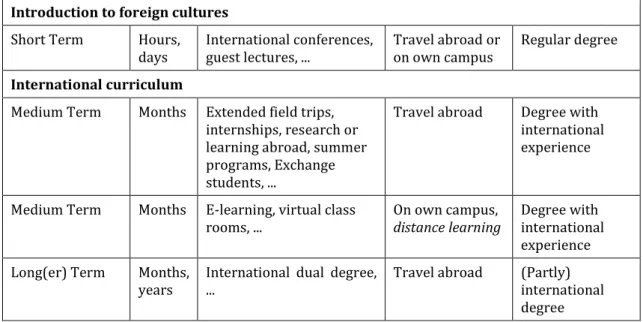
4 Task 3.2: Framework for the assessment of competence gaps
Basic definitions
Motor skill is related to an individual's ability to perform certain motor behaviors, such as speed and accuracy of physical movements or agility. Problem-solving skill is related to an individual's ability to solve new (or unfamiliar) tasks. An individual's competence is built up over time and several factors influence its development, namely: ability, knowledge, understanding, skill, action, experience or motivation (Weinert, 2001).
An individual's intellectual abilities are required for the development of knowledge and the practical utilization and.

Goal of this framework
Outlook of the framework
Working with the framework
In a survey to companies (industry survey - 1), we want to find out what competencies employees must have in the eyes of companies and whether existing employees, incl. In the employee survey (industry survey - 2-3), we want to find out which competencies the employees actually had. In a survey of educational institutions (educational survey - 1), we want to find out which competencies students should acquire through education.
In the survey to the students (education survey - 2) we want to find out which competences the students have actually acquired through their education and whether they are satisfied with it.
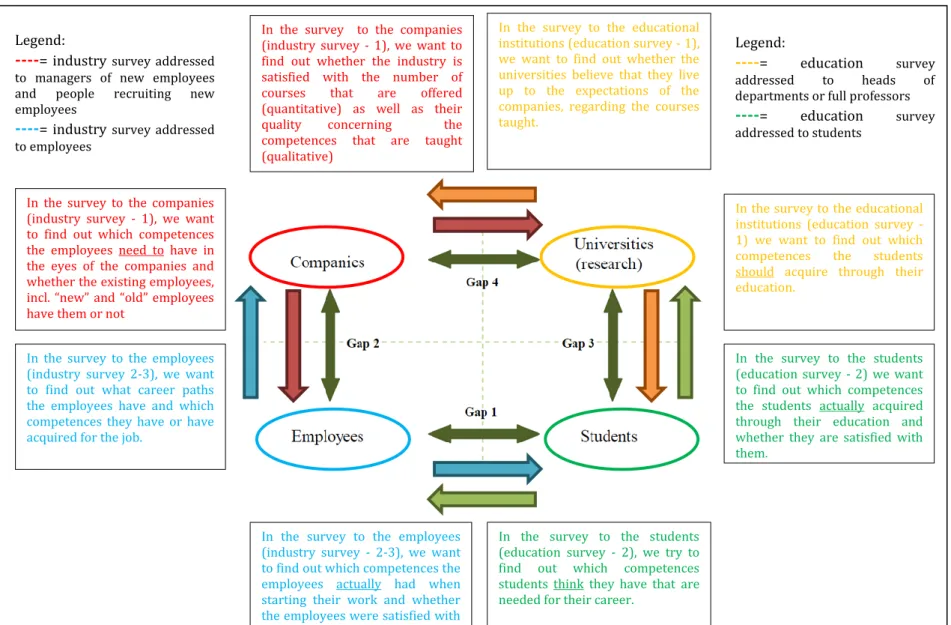
Survey methodology
- Sample size
- Structure of the survey
- Different surveys
In addition, stratified sampling can estimate the state in each stratum in addition to the state of the population. The sample size will be determined based on the tables given in Israel (1992) (see Table 6 and Table 7). The scope of the EDUCAIR project is limited to airlines, airports, air traffic management companies and manufacturers/suppliers.
Looking at Table 7 and considering a precision level of ±5%, the sample size for stratum 1 (companies) is set at 154. A study by the Air Transport Action Group states that the number of jobs created directly by the air transport industry is estimated to have reached 1.9 million in 2010. The population reflecting the scope of the EDUCAIR project, on which the sample size will be based, is estimated to be the direct employment of the sector.
Looking at Table 6 and considering a precision level of ±5%, the sample size for stratum 2 (employees) is set at 400. Each of these sets of questions has one general section asking questions about the respondent's background. This research is carried out by the consortium of the EDUCAIR project, the 7th European Framework Programme.
The objective of the EDUCAIR project is to improve the match between human resource needs in the European air transport and aeronautics sector and the education and training offer. The first part contains general questions to get a picture of the respondent's background.
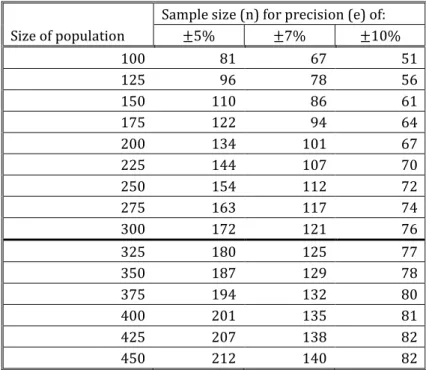
BACKGROUND OF THE RESPONDENT
- AIRPORT INFRASTRUCTURE – DESIGN
- AIRPORT INFRASTRUCTURE – PLANNING
- AIRPORT OPERATIONS – HANDLING
- AIRPORT OPERATIONS – EMERGENCY PLANNING
- AIRPORT OPERATIONS – MAINTENANCE
- AIRPORT OPERATIONS – ENVIRONMENTAL CONTROL
- AIRPORT OPERATIONS – SECURITY
- ATM – AREA CONTROL
- ATC – APPROACH CONTROL
- ATC – TOWER CONTROL
- ATC – OTHER ATC OPERATIONS
- MANUFACTURERS/SUPPLIERS – OPERATIONS
- MANUFACTURERS/SUPPLIERS – ENGINEERING
The target audience of this survey is professionals involved in the management and recruitment of new employees. The survey aims to gather quantitative and qualitative information on the demand for graduates in the air transport and aviation industry and input on educational topics and industry education relationships. Owned by graduates/new hires. experience related to air transport/aeronautics. attributed to perform functions and tasks better.
"Key functions", under the scope of the EDUCAIR Project, include those requiring employees with higher education in aviation/aeronautics related fields. Additionally, they also include those functions that require employees with professional, vocational or corporate training programs in aviation/aeronautics related fields. These programs prepare trainees/employees for jobs that are based on manual or hands-on activities, traditionally non-academic and related to a specific profession and training leading to a license in the air transport sector.
Does your company have formalized training in air transport/aviation topics for entry-level employees in key functions. Lack of knowledge about the air transport/aeronautics sector among students Image of air transport/aeronautics. What are the planned improvements to address recruitment challenges or expectations. strategy changes in the near future.
For each competency, please indicate the extent to which you agree that the competencies are relevant to your organization's operations in the aeronautics/aviation industry. To what extent do you agree that (enhanced) cooperation between industry and educational institutions would benefit the aviation/aviation sector in the following subjects. multiple choice; select one in each row).
OTHER COMMENTS
- AIRPORT INFRASTRUCTURE – DESIGN
- AIRPORT INFRASTRUCTURE – PLANNING
- AIRPORT OPERATIONS – HANDLING
- AIRPORT OPERATIONS – EMERGENCY PLANNING
- AIRPORT OPERATIONS – MAINTENANCE
- AIRPORT OPERATIONS – ENVIRONMENTAL CONTROL
- AIRPORT OPERATIONS – SECURITY
- ATM – AREA CONTROL
- ATC – APPROACH CONTROL
- ATC – TOWER CONTROL
- ATC – OTHER ATC OPERATIONS
- MANUFACTURERS/SUPPLIERS – OPERATIONS
- MANUFACTURERS/SUPPLIERS – ENGINEERING
- AIRPORT INFRASTRUCTURE – DESIGN 1. Strongly
- AIRPORT INFRASTRUCTURE – PLANNING 1. Strongly
- AIRPORT OPERATIONS – HANDLING 1. Strongly
- AIRPORT OPERATIONS – EMERGENCY PLANNING 1. Strongly
- AIRPORT OPERATIONS – MAINTENANCE 1. Strongly
- AIRPORT OPERATIONS – ENVIRONMENTAL CONTROL 1. Strongly
- AIRPORT OPERATIONS – SECURITY 1. Strongly
- ATM – AREA CONTROL 1. Strongly
- ATC – APPROACH CONTROL 1. Strongly
- ATC – TOWER CONTROL 1. Strongly
- ATC – OTHER ATC OPERATIONS 1. Strongly
- AIRPORT INFRASTRUCTURE – DESIGN
- AIRPORT INFRASTRUCTURE – PLANNING
- AIRPORT OPERATIONS – HANDLING
- AIRPORT OPERATIONS – EMERGENCY PLANNING
- AIRPORT OPERATIONS – MAINTENANCE
- AIRPORT OPERATIONS – ENVIRONMENTAL CONTROL
- AIRPORT OPERATIONS – SECURITY
- ATM – AREA CONTROL
- ATC – APPROACH CONTROL
- ATC – TOWER CONTROL
- ATC – OTHER ATC OPERATIONS
- MANUFACTURERS/SUPPLIERS – OPERATIONS
- MANUFACTURERS/SUPPLIERS – ENGINEERING
- Survey – processing the answers
The target audience of this survey are employees of companies active in the air transport and aeronautics sector. Please indicate the method of teaching the aviation/aeronautical education degree (multiple options; select all that apply). For each competency, indicate the extent to which you agree that the competencies are relevant to your activities in the air transport/aeronautics sector and indicate the extent to which you agree that you had them when you graduated. multiple choice; choose one in each row) 23.
Briefly describe your previous attempts to get a job in the aviation/aviation industry (in different companies and/or positions). To what extent do you agree that (enhanced) cooperation between industry and educational institutions would benefit the aviation/aviation sector in the following subjects. multiple choice; select one in each row) 1. How many students graduate (on average) annually from technical programs related to air transport and/or aeronautics at your institution.
Based on your experience, to what extent do you agree that different content areas are important for recruiting new employees in the aviation/aeronautics sector? multiple choice; choose one in each row) ENGINEERING. To what extent do you agree that the qualifications below are relevant for employment in the aviation/aeronautics sector and to what extent do you agree that graduates meet these criteria (pre-employment). multiple choice; select one in each row) EDUCATION & WORK EXPERIENCE. experience related to air transport/aeronautics. Please indicate the type of aviation/aeronautical education offered by your institution and specify. multiple choice; select all that apply).
Please indicate the type of air transport/aeronautical teaching offered by your institution and please specify (multiple choice; select all that apply). Is there any cooperation between your institution and companies in the air transport/aeronautics sector? multiple choice; select all that apply). To what extent do you agree that the following qualifications are important to find a job in the air transport/aeronautics sector? multiple choice; choose one in each row) EDUCATION & WORK EXPERIENCE.
For each competency, please indicate the extent to which you agree that the competencies are relevant to employment in the air transport/aeronautics sector and indicate the extent to which you agree to acquire them through your education. multiple choice; choose one in each row) 38.
5 References
1995), How to Re-engineer your Performance Management Process, London, Kogan Page. 2011), To game or not to game: learning transportation planning with board games, paper presented at TRB 2012 Annual Meeting, 21 p. ICAO (2011a), "Attracting & Retaining - Motivating young people to search out and keep focus on aviation professions.", Training Report, Vol. ICAO (2011b), "The Challenges of Continuous Modernization – Addressing looming skills shortages and the need for sector-wide technology upgrades.", Training Report, Vol. 1992) “Sample Size Determination,” University of Florida, Florida Cooperative Extension Service, Factsheet PEOD-6, 5p. 2000), “A model for international teaming in aircraft design education”, Aircraft Design, 3, pp.
Oxford Economics, Avation, The Real World Wide Web, 127 p. http://www.oxfordeconomics.com/FREE/PDFS/OEAVIATION09.PDF. 2007), "Engineering Study Abroad Programs: Formats, Challenges, Best Practices", Online Journal for Global Engineering Education, vol. What is most important?, American Society for Engineering Education, 13 p. 1995), "Skill Acquisition and Human Performance", Sage Publication, London.

